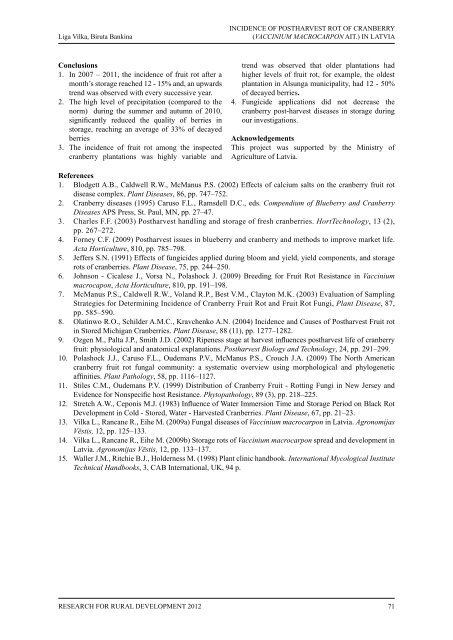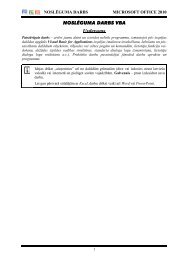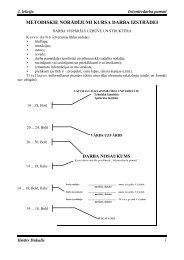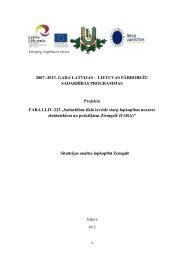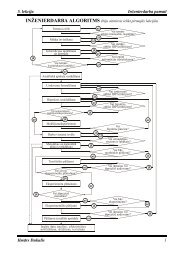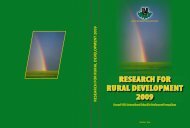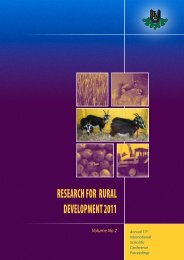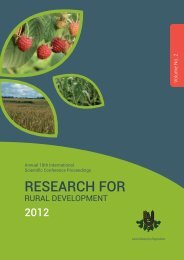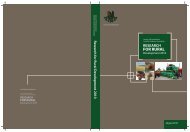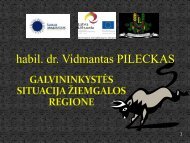Liga Vilka, Biruta BankinaINCIDENCE <strong>OF</strong> POSTHARVEST ROT <strong>OF</strong> CRANBERRY(VACCINIUM MACROCARPON AIT.) IN <strong>LATVIA</strong>Conclusions1. In 2007 – 2011, the incidence of fruit rot after amonth’s storage reached 12 - 15% and, an upwardstrend was observed with every successive year.2. The high level of precipitation (compared to thenorm) during the summer and autumn of 2010,significantly reduced the quality of berries instorage, reaching an average of 33% of decayedberries3. The incidence of fruit rot among the inspectedcranberry plantations was highly variable andtrend was observed that older plantations hadhigher levels of fruit rot, for example, the oldestplantation in Alsunga municipality, had 12 - 50%of decayed berries.4. Fungicide applications did not decrease thecranberry post-harvest diseases in storage duringour investigations.AcknowledgementsThis project was supported by the Ministry ofAgriculture of Latvia.References1. Blodgett A.B., Caldwell R.W., McManus P.S. (2002) Effects of calcium salts on the cranberry fruit rotdisease complex. Plant Diseases, 86, pp. 747–752.2. Cranberry diseases (1995) Caruso F.L., Ramsdell D.C., eds. Compendium of Blueberry and CranberryDiseases APS Press, St. Paul, MN, pp. 27–47.3. Charles F.F. (2003) Postharvest handling and storage of fresh cranberries. HortTechnology, 13 (2),pp. 267–272.4. Forney C.F. (2009) Postharvest issues in blueberry and cranberry and methods to improve market life.Acta Horticulture, 810, pp. 785–798.5. Jeffers S.N. (1991) Effects of fungicides applied during bloom and yield, yield components, and storagerots of cranberries. Plant Disease, 75, pp. 244–250.6. Johnson - Cicalese J., Vorsa N., Polashock J. (2009) Breeding for Fruit Rot Resistance in Vacciniummacrocapon, Acta Horticulture, 810, pp. 191–198.7. McManus P.S., Caldwell R.W., Voland R.P., Best V.M., Clayton M.K. (2003) Evaluation of SamplingStrategies for Determining Incidence of Cranberry Fruit Rot and Fruit Rot Fungi, Plant Disease, 87,pp. 585–590.8. Olatinwo R.O., Schilder A.M.C., Kravchenko A.N. (2004) Incidence and Causes of Postharvest Fruit rotin Stored Michigan Cranberries. Plant Disease, 88 (11), pp. 1277–1282.9. Ozgen M., Palta J.P., Smith J.D. (2002) Ripeness stage at harvest influences postharvest life of cranberryfruit: physiological and anatomical explanations. Postharvest Biology and Technology, 24, pp. 291–299.10. Polashock J.J., Caruso F.L., Oudemans P.V., McManus P.S., Crouch J.A. (2009) The North Americancranberry fruit rot fungal community: a systematic overview using morphological and phylogeneticaffinities. Plant Pathology, 58, pp. 1116–1127.11. Stiles C.M., Oudemans P.V. (1999) Distribution of Cranberry Fruit - Rotting Fungi in New Jersey andEvidence for Nonspecific host Resistance. Phytopathology, 89 (3), pp. 218–225.12. Stretch A.W., Ceponis M.J. (1983) Influence of Water Immersion Time and Storage Period on Black RotDevelopment in Cold - Stored, Water - Harvested Cranberries. Plant Disease, 67, pp. 21–23.13. Vilka L., Rancane R., Eihe M. (2009a) Fungal diseases of Vaccinium macrocarpon in Latvia. AgronomijasVēstis, 12, pp. 125–133.14. Vilka L., Rancane R., Eihe M. (2009b) Storage rots of Vaccinium macrocarpon spread and development inLatvia. Agronomijas Vēstis, 12, pp. 133–137.15. Waller J.M., Ritchie B.J., Holderness M. (1998) Plant clinic handbook. International Mycological InstituteTechnical Handbooks, 3, CAB International, UK, 94 p.Research for Rural Development 201271
AGRICULTURAL SCIENCES (CROP SCIENCES, ANIMAL SCIENCES)Perspectives on TRUFFLE CULTIVATION IN <strong>LATVIA</strong>Diāna Meiere 1 , Antra Balode 1 , Christina Wedén 21Latvia University of Agriculture2Uppsala University, Swedene-mail: trifeleslv@inbox.lv; christina.weden@fkog.uu.seAbstractThis paper discusses some aspects of introducing a new agricultural crop in Latvia – truffles Tuber spp. Truffles aremycorrhiza–forming mushrooms with edible fruit bodies developing in the upper layer of soil. In Latvia, there isa growing interest among farmers to start cultivate truffles. From several cultivated truffle species, the Burgundytruffle Tuber aestivum syn. T. uncinatum is the most suitable to cultivate in Latvia. There are both autochthonous andintroduced tree species in Latvia, which are suitable for the Burgundy truffle cultivation and it is suggested to useQuercus robur, Corylus avellana, Tilia cordata and Fagus sylvatica. In order to find the regions in Latvia with thehighest potential for successful Burgundy truffle cultivation, climate and soil characteristics had been co-analysed.By superimposing soil and climate maps of Latvia, the most suitable regions for truffle cultivation are situated inthe central and southern part of the country. Considering the variability in soil composition even within regions inLatvia, it is thereafter also of great importance to investigate site-specific soil characteristics in order to find the mostfavourable grounds for truffle cultivation. Other truffle species which might be suitable for cultivation in the futureare also discussed, as well as some general recommendations in establishing truffle orchards.Key words: Tuber aestivum, Tuber uncinatum, Tuber spp., climate, soil, Baltic States.IntroductionSearching for and consuming truffles has a longtradition in the Mediterranean region as well asNorthern Africa. Records of consuming the Burgundytruffle (sometimes also referred to as Summer truffle orCommon truffle) Tuber aestivum Vitt. syn. T. uncinatumChat. are known already from ancient Greece. A formof truffle cultivation was exercised already in the 19 thcentury by planting acorns in the naturally truffleproducing areas of Southern France. When the treesdeveloped, they formed mycorrhiza with the trufflespores of various species present in the ground, whicheventually could lead to truffle fruit body production.In the late 1960s, intense research efforts started inItaly and France in order to produce greenhouse treeseedlings harbouring truffle mycorrhiza (Chevalierand Palenzona, 2008), for efficient truffle cultivation.These efforts were a direct effect of the stronglydeclining natural harvests of the Périgord black truffleTuber melanosporum Vitt. After ensuring propertruffle colonisation of the root system, the seedlingscould be planted in orchards. This also meant thattruffles could be potentially grown in areas, or evencontinents, where there were no previously existingnatural populations of these truffle species. Todaytruffle cultivation has expanded and is established alsooutside of the traditionally truffle producing countriesof Southern Europe. Truffle orchards on a commercialor experimental scale have been established in Centraland Northern Europe (Hungary, Sweden, Poland,Finland), Americas (Canada, USA, Argentina, Chili),North Africa (Morocco), Asia (China), New Zealandand Australia (Chevalier, 2010). As yet, only a fewof the gastronomically and hence economicallyimportant truffle species are commercially availablefor truffle cultivation.An interest in truffle cultivation has arisen alsoin Latvia. Despite that Latvia is a relatively smallcountry, with a total area of 64,000 km 2 , there aremarked differences in climate and geology withinthe country, which may affect the success of trufflecultivation. Latvia is close to the northern border oreven outside the distribution area of most commercialtruffle species. Occurrence of edible truffle species inLatvia or adjacent areas would be a very importantindication for choosing the right species for successfulcultivation. So far, there are no confirmed finds ofedible truffle fruitbodies from Latvia. Findings ofblack truffles in Latvia were reported by severalauthors at the end of 18th and beginning of the 19thcentury. Famous mycologist, specialist of hypogeousfungi of the beginning of 20 th century FedorBucholtz (Бухгольц, 1902) attributed the old 19thcentury reports from Latvia to the Burgundy truffleT. aestivum. He cited literature data and reportedblack truffle finds from Russia and adjacent areas,including St Petersburg, Estonia, Lithuania, Ukraineand Moscow region. Which truffle species werefound, remains to be confirmed until finding of theold herbaria collections or making new collectionsfrom these areas. Today, the known localities of thewild Burgundy truffle closest to Latvia are from theSwedish islands of Gotland and Öland (Wedén et al.,2004), the southern part of Poland (Ławrynowicz etal., 2008) and Belarus (Гапиенко, 2006). The edibleand closely related Bagnoli truffle Tuber mesentericumVitt. is also known from Sweden (Gotland) and Poland(Ławrynovicz, 1988). The Bianchetto truffle Tuberborchii Vitt. has been reported from Denmark and theUK (Pegler et al., 1993), Lithuania (Kataržytė, 2009),Poland and even southern Finland (Ławrynovicz,1990). From neighboring Lithuania, which has very72 Research for Rural Development 2012


